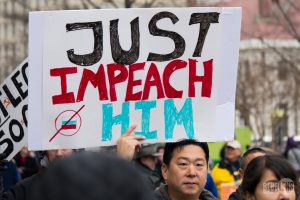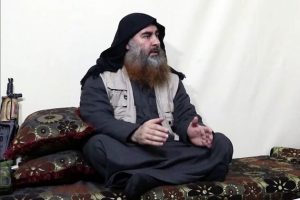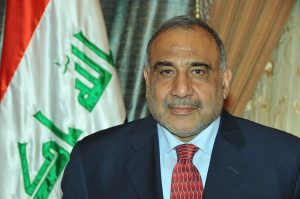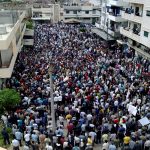by Wayne White
Regardless of its terrorist spectacles abroad, from Beirut to Paris, the Islamic State (ISIS or IS) continues to lose territory in its Syrian-Iraqi base. Large dollops of US ground forces in roles closer to the fighting are not the answer. Especially in the case of Iraq, more US troops in frontline roles would likely cause already reticent Iraqi forces to rely more heavily on Americans to do their fighting for them. Unfortunately, virtually all local forces now fighting are hostile to the Sunni Arabs who constitute most of the population inside IS territory. But foreign occupation is no substitute.
The Islamic State has become more vulnerable. Its finances have deteriorated to the point where its fighters’ pay was reduced earlier this year, and desertions are rising. In Iraq, it continues to lose territory (albeit slowly) such as the town of al-Hit on the Euphrates near the Syrian border earlier this month. More significantly, the IS military position in Syria has become dangerously exposed following gains by the Assad regime and Kurdish Defense Forces (YPG).
Broad YPG conquests across northern Syria, gains by Syrian troops and their various allied forces in western Syria, and the regime’s lunge eastward to Palmyra in the south leave much of the Islamic State’s holdings in western and central Syria threatened on three sides. The IS capital Raqqa is vulnerable to US-backed YPG forces from the north and pro-regime forces from the south.
IS fanatics will resist fiercely in and around Raqqa, but this relatively small city does not pose quite the urban warfare challenge represented by IS holdings in Aleppo or its vastly larger stronghold in Mosul in Iraq. Similarly, regime forces can thrust northeast from Palmyra to relieve the beleaguered government garrison still inside the small city of Deir ez-Zor, also not far from YPG frontlines in eastern Syria. If either city falls to what could be pincer-style attacks from north and south, IS forces in western Syria would be cut off. Such advances could begin soon.
These moves, at least on the part of the Syrian regime, might have gotten underway already. But heavy regime forces were instead recently committed to a campaign focused on the shattered city of Aleppo and its environs in Syria’s northeast. This resulted from the breakdown of the shaky “Cessation of Hostilities.” There, the Assad regime is now pushing to surround Syria’s largest city and choke off access corridors to the Turkish border for moderate rebels, the al-Qaeda-affiliated al-Nusra Front, and IS. Also, this area is closer to pro-regime bastions and lines of communication in Syria’s heavily populated west.
For IS, the overall picture is less ominous in Iraq where its forces are dug into denser urban settings. Also, it only has to cope with US and coalition air strikes, not Russian bombing and heavy artillery as well. Most importantly, neither Iraqi Army nor Kurdish forces measure up to their various Syrian counterparts in effectiveness.
Despite three high-profile successes in 13 months—the recapture of Tikrit, Ramadi and al-Hit— the performance of the Iraqi Army has been at best uneven. In fact, spearheading much of the fighting in Tikrit were abusive Shi’a militias, now largely banned from the government’s military effort. Government forces finally secured Ramadi last February, but only after areas of the city changed hands repeatedly during 2014-2015, showcasing the Iraqi Army’s problems.
To achieve these limited gains, Baghdad relied heavily on intense coalition air strikes and anti-IS local Sunni Arab tribesmen (the latter typically performing better than the army despite being less well equipped). And a dysfunctional, corrupt Iraqi government unable to offer concessions to woo more Sunni Arabs to turn against IS is now gripped by a major crisis over political reform. This drew Vice President Joe Biden to Baghdad on April 28 hoping to reduce the adverse impact on the anti-Islamic State struggle. Yet, on April 30 demonstrators stormed part of the government’s heavily secured Baghdad “Green Zone” demanding the ouster of corrupt, sectarian ministers.
Clearly, there is no need for new extensive commitments of US military personnel to northern Syria because IS, although still formidable there, already is in danger. The problem hindering the YPG most is adequate weapons and munitions, which the US promised to augment last week by air drop along with 250 Special Operations Forces to assist YPG units. Just about any large ground gains against IS in central and eastern Syria would worsen its increasingly perilous battlefield situation. At some point when pro-regime and largely YPG forces make their move against Raqqa (perhaps also Deir ez-Zor), IS leaders and forces will have to choose between dying there in a bloody, but futile stand, or falling back into Iraq to preserve as much of their remaining fighting power as possible.
Matters in Iraq are less encouraging, thanks to the vengefully anti-Sunni Arab ruling elite in Baghdad. Charges that the Obama administration is responsible for this situation are misplaced. The government of Nouri al-Maliki trashed the US-forged “Sunni Arab Awakening” sectarian peace accord and then drove Sunni Arabs over the brink with aggressive political exclusion and persecution. Maliki’s dismal profile already was evident during 2007-2008. Yet, the Bush administration set in place the phased US withdrawal agreement followed by President Obama. Only when the Islamic State was at the door was Maliki driven out of office in 2014 and his successor Haider al-Abadi accepted the terms allowing US troops back in Iraq.
Sending US combat troops to Iraq is unwise. Something more like “tough love” is needed. Iraqi troops have made gains, but these sometimes shaky, casualty-averse forces would like nothing better than to outsource to Americans what they should be doing themselves.
Moreover, bombastic Donald Trump-style US presidential campaign declarations that the US would decisively take down IS only serve to increase expectations among wary Iraqi troops that maybe they won’t have to put themselves in harm’s way. Already, in March, a US Marine died when Marines had to occupy a base abandoned by fleeing Iraqi soldiers. A US military advisor to Iraqi Kurdish forces died today when IS assault forces smashed several miles through Kurdish front lines facing Mosul and killed the US soldier with direct fire. So, although risky given the shortcoming of various combatants facing IS in Iraq, a better approach in both Syria and Iraq would be to stand firm in sending only US advisors and munitions, not combatants.
Beefed-up US mentoring and aerial firepower has been invaluable and could be upgraded somewhat, but it cannot substitute for lackluster, under-motivated troops. The Bush administration invested billions of dollars in training and equipping the Iraqi Army. Much of that army swiftly disintegrated, abandoning most of its US weapons to IS forces—and in the face of far less numerous attackers back in 2014. Having regrouped amidst crisis and aided by the Obama administration, the current Iraqi forces could make further gains.
A troubling reality spanning both Syrian and Iraq is that all significant indigenous forces closing in on IS pose a threat to its inhabitants: Sunni Arabs. All of the various contending factions—those close to the Syrian regime such as Alawites, Christians, and various Iranian-backed Shi’a as well as YPG Kurds, Iraqi Kurds, and the largely Shi’a Iraqi Army—tend to mistreat Sunni Arabs, want to strip them of territory, or both. Also, in terms of state-building in former IS territories, cities, and towns are being devastated by the rain of bombs and artillery typically required during their “liberation” along with IS combat car bombs, mines, and booby traps. Many grievances giving rise to IS will likely remain, generating sporadic guerrilla attacks by diehard fanatics for years.
US and coalition forces as occupation troops would be confronted everywhere by the same widespread destruction. Western state-building in far better circumstances has largely failed. This probably would be mission impossible, and there would be a heavy cost in blood and treasure. Such a grim reality is one more reason, despite inevitable local failings, to avoid large-scale US/Western military intervention, which would quite possibly draw foreign troops into a lengthy period of occupation thereafter.
Photo: Kurdish peshmerga taking part in operations against the Islamic State (Times asi via Flickr)





